PART
1
The Basics
Healthy
of the
Brain
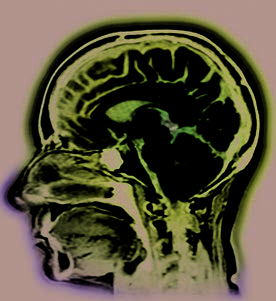

To understand AD, it is important to The Brain’s
know a bit about the brain. This part of
Vital Statistics
Unraveling the Mystery gives an inside
view of the normal brain, how it works,
and what happens during aging.
ADULT WEIGHT
The brain is a remarkable organ. Seemingly
about 3 pounds
without effort, it allows us to carry out every
ADULT SIZE
element of our daily lives. It manages many body
a medium cauliflower
functions, such as breathing, blood circulation,
NUMBER OF NEURONS
and digestion, without our knowledge or
about 100,000,000,000 (100 billion)
direction. It also directs all the functions we carry
out consciously. We can speak, hear, see, move,
NUMBER OF SYNAPSES
remember, feel emotions, and make decisions
(the gaps between neurons)
because of the complicated mix of chemical and
about 100,000,000,000,000 (100 trillion)
electrical processes that take place in our brains.
NUMBER OF CAPILLARIES
The brain is made of nerve cells and several
(tiny blood vessels)
other cell types. Nerve cells also are called
about 400,000,000,000 (400 billion)
neurons. The neurons of all animals function in
basically the same way, even though animals can
be very different from each other. Neurons survive the brain is only about 2 percent of the body’s and function with the help and support of glial
weight, it receives 20 percent of the body’s blood
cells, the other main type of cell in the brain. Glial supply. Billions of tiny blood vessels, or capillaries, cells hold neurons in place, provide them with
carry oxygen, glucose (the brain’s principal source
nutrients, rid the brain of damaged cells and other of energy), nutrients, and hormones to brain cells cellular debris, and provide insulation to neurons
so they can do their work. Capillaries also carry
in the brain and spinal cord. In fact, the brain
away waste products.
has many more glial cells than neurons—some
scientists estimate even 10 times as many.
Another essential feature of the brain is its
enormous network of blood vessels. Even though
ALZHEIMER’S DISEASE Unraveling the Mystery 9
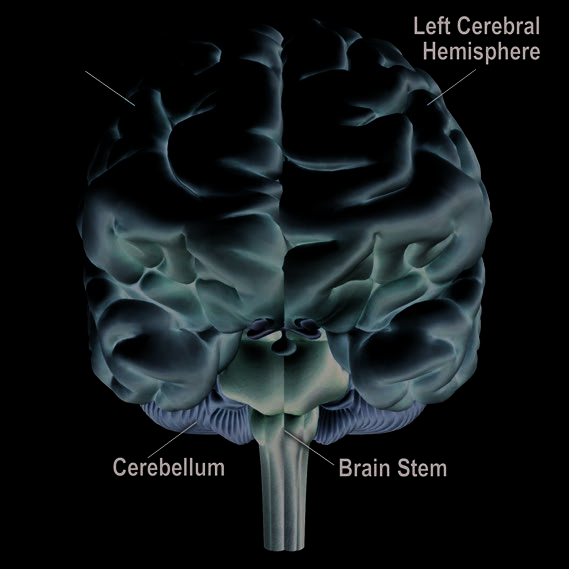
P A R T 1 The Basics of the Healthy Brain
Inside the
Human Brain
The brain has many parts, each of which ■The occipital lobe, which is at the back of the is responsible for particular functions.
brain, is concerned with vision.
The following section describes a few
■ The temporal lobe, which runs along the
key structures and what they do.
side of the brain under the frontal and pari-
etal lobes, deals with the senses of smell, taste,
THE MAIN PLAYERS
and sound, and the formation and storage of
■ Two cerebral hemispheres account for 85 per-
memories.
cent of the brain’s weight. The billions of neurons
in the two hemispheres are connected by thick
■ The cerebellum sits above the brain stem and
bundles of nerve cell fibers called the corpus cal-
beneath the occipital lobe. It takes up a little more
losum. Scientists now think that the two hemi-
than 10 percent of the brain. This part of the
spheres differ not so much in what they do (the
brain plays roles in balance and coordination. The
“logical versus artistic” notion), but in how they
cerebellum has two hemispheres, which receive
process information. The left hemisphere appears
information from the eyes, ears, and muscles and
to focus on details (such as recognizing a particular
face in a crowd). The right hemisphere focuses on
broad background (such as understanding the rela- Front View of the Brain tive position of objects in a space). The cerebral
hemispheres have an outer layer called the cerebral
cortex. This is where the brain processes sensory
information received from the outside world,
controls voluntary movement, and regulates
cognitive functions, such as thinking, learning,
speaking, remembering, and making decisions.
The hemispheres have four lobes, each of which
has different roles:
■ The frontal lobe, which is in the front of the
brain, controls “executive function” activities
like thinking, organizing, planning, and
problem solving, as well as memory, attention,
and movement.
■ The parietal lobe, which sits behind the
frontal lobe, deals with the perception and
integration of stimuli from the senses.
10 ALZHEIMER’S DISEASE Unraveling the Mystery
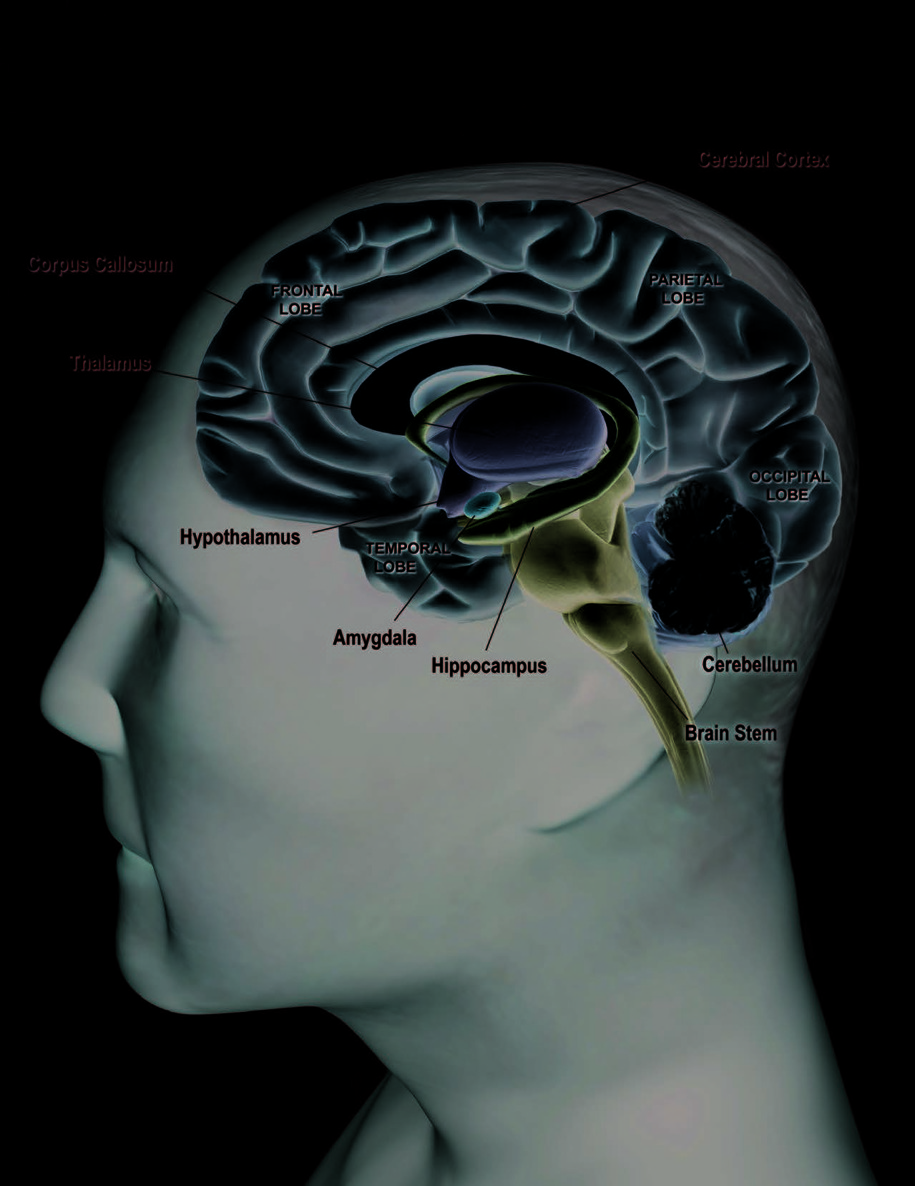
Side View of the Brain
This illustration shows a three-dimensional side
view of one of two cerebral hemispheres of the brain.
To help visualize this, imagine looking at the cut side
of an avocado sliced long ways in half, with the
pit still in the fruit. In this illustration, the “pit” is
several key structures that lie deep within the brain
(the hypothalamus, amygdala, and hippocampus)
and the brain stem.
P A R T 1 The Basics of the Healthy Brain
joints about the body’s movements and position.
■ The hippocampus, which is buried in the
Once the cerebellum processes that information, it temporal lobe, is important for learning and sends instructions to the body through the rest of
short-term memory. This part of the brain is
the brain and spinal cord. The cerebellum’s work
thought to be the site where short-term
allows us to move smoothly, maintain our balance, memories are converted into long-term and turn around without even thinking about it. It memories for storage in other brain areas.
also is involved with motor learning and remem-
■ The thalamus, located at the top of the brain
bering how to do things like drive a car or write
stem, receives sensory and limbic information,
your name.
processes it, and then sends it to the cerebral
■ The brain stem sits at the base of the brain. It
cortex.
connects the spinal cord with the rest of the brain. ■ The hypothalamus, a structure under Even though it is the smallest of the three main
the thalamus, monitors activities such as body
players, its functions are crucial to survival. The
temperature and food intake. It issues instructions
brain stem controls the functions that happen
to correct any imbalances. The hypothalamus also
automatically to keep us alive—our heart rate,
controls the body’s internal clock.
blood pressure, and breathing. It also relays
information between the brain and the spinal
THE BRAIN IN ACTION
cord, which then sends out messages to the
Sophisticated brain-imaging techniques allow
muscles, skin, and other organs. Sleep and
scientists to monitor brain function in living peo-
dreaming are also controlled by the brain stem.
ple and to see how various parts of the brain are
used for different kinds of tasks. This is
OTHER CRUCIAL PARTS
opening up worlds of knowledge about brain
Several other essential parts of the brain lie deep
function and how it changes with age or disease.
inside the cerebral hemispheres in a network of
One of these imaging techniques is called
structures called the limbic system. The limbic
positron emission tomography, or PET
system links the brain stem with the higher
scanning. Some PET scans measure blood
reasoning elements of the cerebral cortex. It plays flow and glucose metabolism throughout the a key role in developing and carrying out instinc-brain. (For more on metabolism, see page 16.)
tive behaviors and emotions and also is import-
During a PET scan, a small amount of a radioac-
ant in perceiving smells and linking them with
tive substance is attached to a compound, such
memory, emotion, and instinctive behaviors. The
as glucose, and injected into the bloodstream.
limbic system includes:
This tracer substance eventually goes to the brain.
When nerve cells in a region of the brain become
■ The amygdala, an almond-shaped structure
involved in processing and remembering strong
active, blood flow and glucose metabolism in that
emotions such as fear. It is located in the temporal region increase. When colored to reflect metabol-lobe just in front of the hippocampus.
ic activity, increases usually look red and yellow.
Shades of blue and black indicate decreased or no
activity within a brain region.
12 ALZHEIMER’S DISEASE Unraveling the Mystery
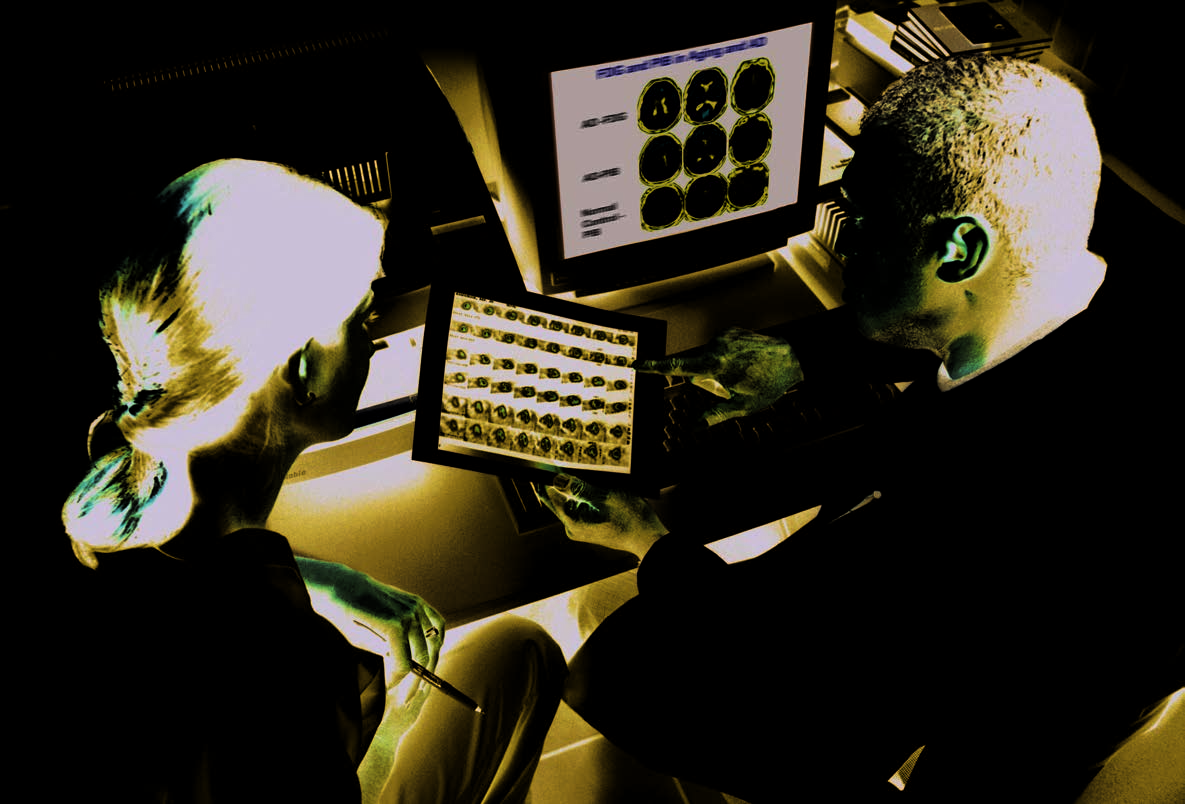
In essence, a PET scan produces a “map” of
serotonin. (To learn about exciting developments
the active brain.
using one new tracer, see PiB and PET on page
Scientists can use PET scans to see what hap-
28.) Some of these neurotransmitters are changed
pens in the brain when a person is engaged in
with age, disease, and drug therapies.
a physical or mental activity, at rest, or even
while sleeping or dreaming. Certain tracers can
track the activity of brain chemicals, for example
neurotransmitters such as dopamine and
ALZHEIMER’S DISEASE Unraveling the Mystery 13
P A R T 1 The Basics of the Healthy Brain
Neurons
and Their Jobs
The human brain is made up of billions to survive and stay healthy. These processes are of neurons. Each has a cell body,
communication, metabolism, and repair.
an axon, and many dendrites. The
cell body contains a nucleus, which
COMMUNICATION
controls much of the cell’s activities. The cell
Imagine the many miles of fiber-optic cables that
body also contains other structures, called
run under our streets. Day and night, millions of
organelles, that perform specific tasks.
televised and telephonic messages flash at incredible
The axon, which is much narrower than the
speeds, letting people strike deals, give instructions,
width of a human hair, extends out from the cell
share a laugh, or learn some news. Miniaturize it,
body. Axons transmit messages from neuron to
multiply it many-fold, make it much more complex,
neuron. Sometimes, signal transmissions—like
and you have the brain. Neurons are the great com-
those from head to toe—have to travel over very
municators, always in touch with their neighbors.
long distances. Axons are covered with an insulat-
Neurons communicate with each other through
ing layer called myelin (also called white matter
their axons and dendrites. When a dendrite re-
because of its whitish color). Myelin, which is
ceives an incoming signal (electrical or chemical),
made by a particular kind of glial cell, increases
an “action potential,” or nerve impulse, can be
the speed of nerve signal transmissions through
generated in the cell body. The action potential
the brain.
travels to the end of the axon and once there, the
Dendrites also branch out from the cell body.
passage of either electrical current or, more
They receive messages from the axons of other
typically, the release of chemical messengers,
neurons. Each neuron is connected to thousands
called neurotransmitters, can be triggered. The
of other nerve cells through its axon and dendrites. neurotransmitters are released from the axon Groups of neurons in the brain have special
terminal and move across a tiny gap, or synapse,
jobs. For example, some are involved with
to specific receptor sites on the receiving, or post-
thinking, learning, and memory. Others are
synaptic, end of dendrites of nearby neurons. A
responsible for receiving information from the
typical neuron has thousands of synaptic connec-
sensory organs (such as the eyes and ears) or the
tions, mostly on its many dendrites, with other
skin. Still others communicate with muscles,
neurons. Cell bodies also have receptor sites for
stimulating them into action.
neurotransmitters.
Several processes all have to work smoothly
together for neurons, and the whole organism,
14 ALZHEIMER’S DISEASE Unraveling the Mystery
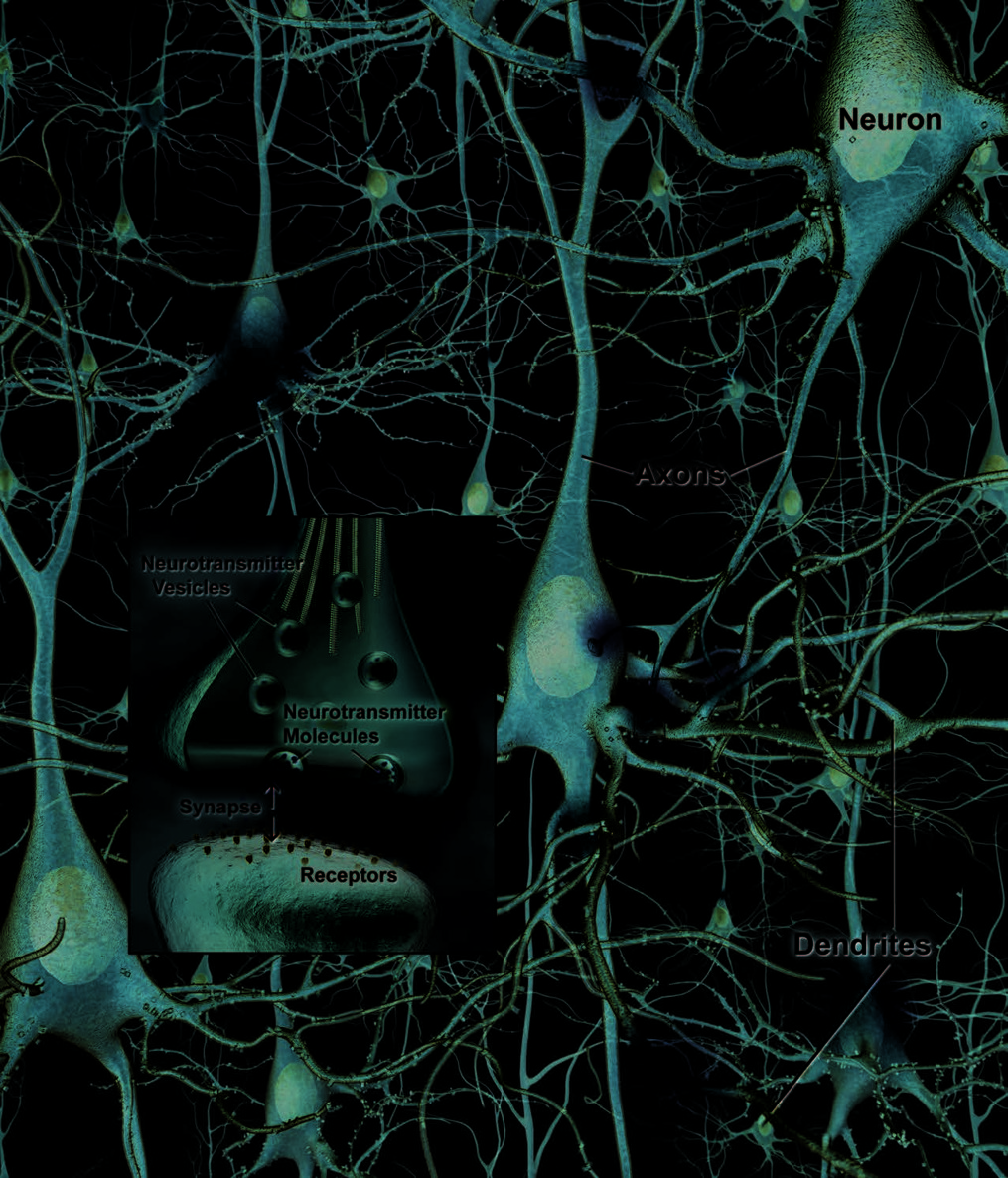
Neurons in the Brain
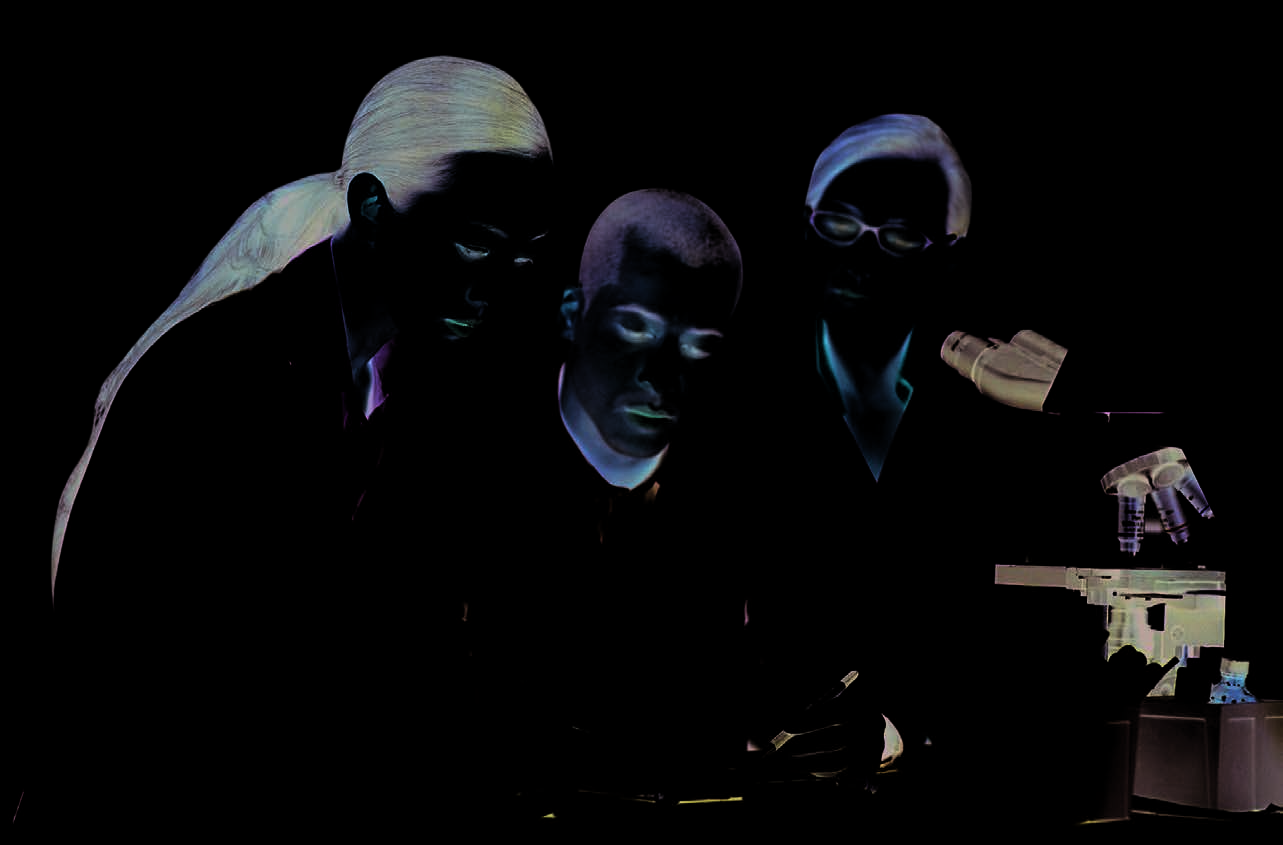
P A R T 1 The Basics of the Healthy Brain
Once the post-synaptic receptors are activated,
METABOLISM
they open channels through the cell membrane
All cells break down chemicals and nutrients to
into the receiving nerve cell’s interior or start other generate energy and form building blocks that processes that determine what the receiving nerve
make new cellular molecules such as proteins.
cell will do. Some neurotransmitters inhibit nerve This process is called metabolism. To maintain cell function (that is, they make it less likely that
metabolism, the brain needs plenty of blood
the nerve cell will send an electrical signal down
constantly circulating through its billions of
its axon). Other neurotransmitters stimulate nerve capillaries to supply neurons and other brain cells, priming the receiving cell to become active
cells with oxygen and glucose. Without oxygen
or send an electrical signal down the axon to more and glucose, neurons will quickly die.
neurons in the pathway. A neuron receives signals
from many other neurons simultaneously, and the REPAIR
sum of a neuron’s neurotransmitter inputs at any
Nerve cells are formed during fetal life and for a
one instant will determine whether it sends a sig-
short time after birth. Unlike most cells, which
nal down its axon to activate or inhibit the action
have a fairly short lifespan, neurons in the brain
of other neighboring neurons.
live a long time. These cells can live for up to 100
During any one moment, millions of these sig- years or longer. To stay healthy, living neurons nals are speeding through pathways in the brain,
must constantly maintain and repair themselves.
allowing the brain to receive and process informa- In an adult, when neurons die because of disease tion, make adjustments, and send out instructions or injury, they are not usually replaced. Research, to various parts of the body.
however, shows that in a few brain regions, new
neurons can be generated, even in the old brain.

The
Changing Brain
inHealthyAging
In the past several decades, investigators have ■ In some people, structures called plaques and learned much about what happens in the
tangles develop outside of and inside neurons,
brain when people have a neurodegenerative
respectively, although in much smaller amounts
disease such as Parkinson’s disease, AD, or
than in AD (see The Hallmarks of AD on page 21
other dementias. Their findings also have revealed for more information on plaques and tangles).
much about what happens during healthy aging.
■ Damage by free radicals increases (free radicals
Researchers are investigating a number of chang-
are a kind of molecule that reacts easily with other
es related to healthy aging in hopes of learning
molecules; see The Aging Process on page 42 for
more about this process so they can fill gaps in our more on these molecules).
knowledge about the early stages of AD.
■ Inflammation increases (inflammation is the
As a person gets older, changes occur in all parts complex process that occurs when the body of the body, including the brain:
responds to an injury, disease, or abnormal
situation).
■ Certain parts of the brain shrink, especially
the prefrontal cortex (an area at the front of the
What effects does aging have on mental
frontal lobe) and the hippocampus. Both areas
function in healthy older people? Some people
are important to learning, memory, planning, and may notice a modest decline in their ability to other complex mental activities.
learn new things and retrieve information, such
■ Changes in neurons and neurotransmitters
as remembering names. They may perform worse
affect communication between neurons. In certain on complex tasks of attention, learning, and brain regions, communication between neurons
memory than would a younger person. However,
can be reduced because white matter (myelin-
if given enough time to perform the task, the
covered axons) is degraded or lost.
scores of healthy people in their 70s and 80s are
■ Changes in the brain’s blood vessels occur.
often similar to those of young adults. In fact, as
Blood flow can be reduced because arteries narrow they age, adults often improve in other cognitive and less growth of new capillaries occurs.
areas, such as vocabulary and other forms of verbal
knowledge.
It also appears that additional brain regions can
be activated in older adults during cognitive tasks,
ALZHEIMER’S DISEASE Unraveling the Mystery 17
P A R T 1 The Basics of the Healthy Brain
such as taking a memory test. Researchers do not
and unique mix of genetics, environment, and life
fully understand why this happens, but one idea is experiences, the balance may tip in favor of a dis-that the brain engages mechanisms to compensate ease process that will ultimately lead to dementia.
for difficulties that certain regions may be having. For another person, with a different reserve and For example, the brain may recruit alternate brain a different mix of genetics, environment, and life networks in order to perform a task. These find-experiences, the balance may result in no apparent
ings have led many scientists to believe that major decline in cognitive function with age.
declines in mental abilities are not inevitable as
Scientists are increasingly interested in the
people age. Growing evidence of the adaptive
influence of all these factors on brain health, and
(what scientists call “plastic”) capabilities of the
studies are revealing some clues about actions
older brain provide hope that people may be able
people can take that may help preserve healthy
to do things to sustain good brain function as
brain aging. Fortunately, these actions also benefit
they age. A variety of interacting factors, such as
a person’s overall health. They include:
lifestyle, overall health, environment, and genetics
also may play a role.
■ Controlling risk factors for chronic disease,
Another question that scientists are asking
such as heart disease and diabetes (for example,
is why some people remain cognitively healthy
keeping blood cholesterol and blood pressure at
as they get older while others develop cognitive
healthy levels and maintaining a healthy weight)
impairment or dementia. The concept of
■ Enjoying regular exercise and physical activity
“cognitive reserve” may provide some insights.
■ Eating a healthy diet that includes plenty of
Cognitive reserve refers to the brain’s ability to
vegetables and fruits
operate effectively even when some function is
■ Engaging in intellectually stimulating activities
disrupted. It also refers to the amount of damage
and maintaining close social ties with family,
that the brain can sustain before changes in
friends, and community
cognition are evident. People vary in the cognitive
Vascular Disease on page 43 and Lifestyle
reserve they have, and this variability may be
Factors on page 45 provide more information
because of differences in genetics, education,
about these issues and how they may influence the
occupation, lifestyle, leisure activities, or other life risk of developing AD.
experiences. These factors could provide a certain
amount of tolerance and ability to adapt to change
and damage that occurs during aging. At some
point, depending on a person’s cognitive reserve
18 ALZHEIMER’S DISEASE Unraveling the Mystery
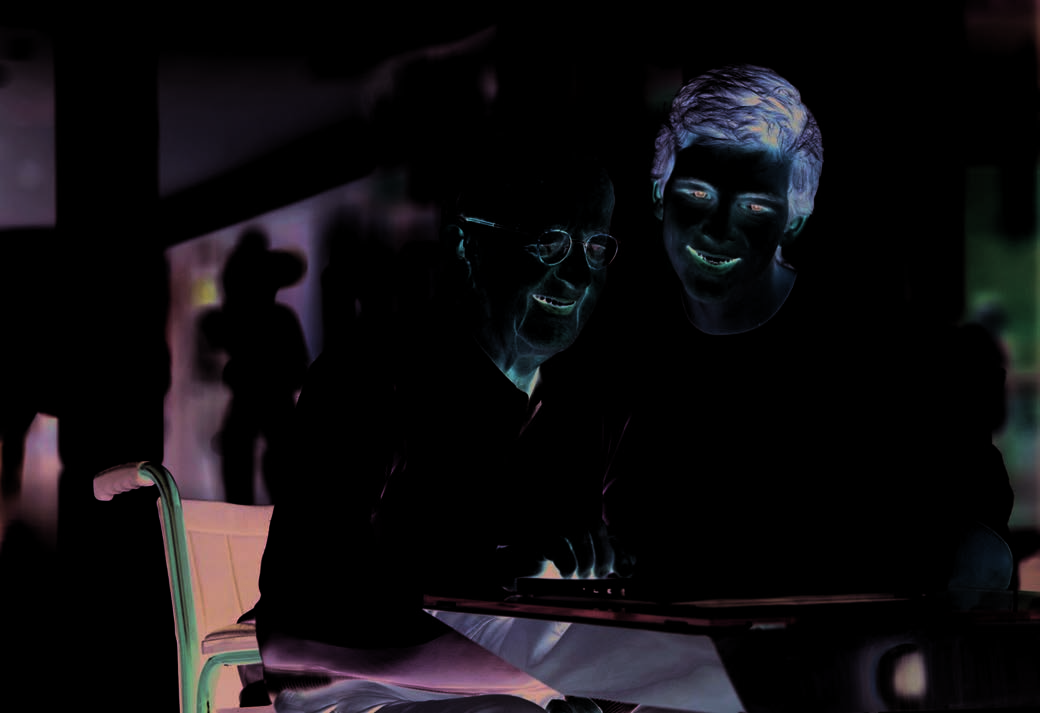
ACTIVE Study May Provide Clues to Help Older Adults Stay Mentally Sharp The phrase “use it or lose it” may make you think ■ After 5 years, people in each group performed of your muscles, but scientists who study brain
better on tests in their respective areas of training
health in older people have found that it may apply
than did people in the control group. The reasoning
to cognitive skills as well. In 2006, scientists funded
and processing-speed groups who received booster
by NIA and the National Institute of Nursing Research
training had the greatest benefit.
completed a study of cognitive training in older adults.
The researchers also looked at the training’s effects
This study, the Advanced Cognitive Training for Inde-
on participants’ everyday lives. After 5 years, all three
pendent and Vital Elderly (ACTIVE) study, was the first
groups who recieved training reported less difficulty
randomized controlled trial to demonstrate long-lasting, than the control group in tasks such as preparing positive effects of brief cognitive training in older adults. meals, managing money, and doing housework.
T












